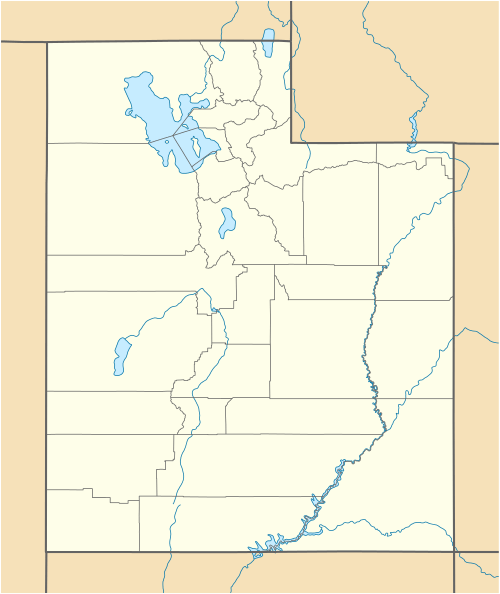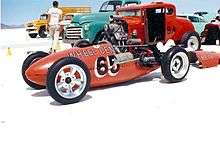Bonneville Speedway
Coordinates: 40°45′45″N 113°53′44″W / 40.762522°N 113.895520°W
|
Bonneville Salt Flats Race Track | |
|
Phoenix Diesel Truck running at the Bonneville Speedway | |
  | |
| Nearest city | Wendover, Utah |
|---|---|
| Area | 36,650 acres (14,830 ha) |
| Built | 1911 |
| NRHP Reference # | 75001826[1] |
| Added to NRHP | March 16, 1984 |

Bonneville Speedway is an area of the Bonneville Salt Flats near Wendover, Utah, that is marked out for motor sports. It is particularly noted as the venue for numerous land speed records.
The salt flats were first used for motor sports in 1912, but did not become truly popular until the 1930s when Ab Jenkins and Sir Malcolm Campbell competed to set land speed records.
A reduction of available racing surface and salt thickness has led to the cancellation of events at Bonneville, such as Speed Week in 2014 and 2015.[3] Available racing surface is much reduced with just 2.5 miles available[3] instead of the 9 mile courses traditionally used for Speed Week.[4]
Track layouts
Historically, the speedway was marked out by the Utah Department of Transportation at the start of each summer. Originally, two tracks were prepared; a 10 mile long straightaway for speed trials and an oval or circular track for distance runs, which was typically between 10 and 12 miles (16 and 19 km) long depending on the condition of the salt surface.
Since at least the 1990s, track preparations have been the responsibility of the event organizers. Days or weeks in advance, the track preparers identify an area best suited for their track layouts and begin grading the tracks. Surveyors are brought in to survey the timing trap distances. A day before racing begins, the track markers are added.
Originally, the straightaway was marked with a broad black line down its center. This was eventually changed to lines down either side, as the center line wore out too quickly. As the costs for painting the lines has gone up, organizations have switched to flags and cones as track markers. The last event to use black lines was Speed Week, August 2009.[5]
The number of tracks and the timed sections for each track are set according to what is most beneficial for each event. Large public meets such as Speed Week run as many as four tracks with several timed miles, usually starting with the second mile and running to the fifth mile. Smaller meets that typically only run world record attempts will utilize a single track, with one timed mile and one timed kilometer in the middle of the track. Additional marks and cones indicate the end of the track and the position of timing equipment.
Deteriorating track conditions
The annual Speed Week was cancelled in both 2014 and 2015, as were many land-speed racing events, due to deteriorating track conditions.[3][4] Heavy rains caused a layer of mud from surrounding mountains to flow onto the flats, covering approximately 6 mi (9.7 km) of the track. Another section of the flats would normally be used, however, nearby salt mining operations have reduced the size of the usable track.[4]
The depth of the salt crust at Bonneville has also been decreasing, possibly leached into a saltwater aquifer. Measured at as much at 3 ft (0.91 m) in the 1940s and 50s, it has been reduced to just 0.17 ft (0.052 m) in 2015. Although studies were made since 1960, the causes are not totally clear, being the weather and salt mining exploration the main issuer. Some strategies were pulled out to revert the decreasing of the salt surface, such as pumping back some salt resulting from mining with no result.[4]
Events and meetings
In August, the Southern California Timing Association[6] and Bonneville Nationals Inc.[7] organize Speed Week, the largest meet of the year, which attracts several hundred drivers who compete to set highest speed in a range of categories.
In late August, the BUB Motorcycle Speed Trials are held.[8]
In September each year is the World of Speed, (similar to Speed Week) organized by the Utah Salt Flats Racing Association.[9] The USFRA also meet on the first Wednesday of each month throughout the summer.
In October, the Southern California Timing Association puts on World Finals, a scaled-down version of Speed Week.
Each year, there are usually a few private meets that are not publicized scattered among the larger public meets.
Land speed records
Numerous land speed records in various vehicle categories and classes have been set on the Bonneville speed way. In 1960, Mickey Thompson became the first American to break the 400 mph (644 km/h) barrier, hitting 406.60 mph and (654.36 km/h) surpassing John Cobb's 1947 one-way Land speed record of 403 mph (649 km/h). Other notable examples of Bonneville speed records include:


| Year | Driver | Vehicle | Speed mph | Speed km/h | Class (category) | Notes |
|---|---|---|---|---|---|---|
| 1935 | Sir Malcolm Campbell | Blue Bird | 301.129 | 484.620 | [data needed] | |
| 1947 | Don Waite | The Edelbrock Special | 192 | 309 | [data needed] | |
| 1954 | George J Smith | Harley-Davidson knucklehead | 152.02 | 244.652 | [data needed] | Modified 91 ci knucklehead / alcohol |
| 1963 | Craig Breedlove | Spirit of America | 407.447 | 655.722 | [data needed] | |
| 1963 | Dick Beith | Pepco 36 hp VW Lakester | 129.68 | 208.700 | K36 Unlimited | Pepco supercharged 36 hp based engine in a „Lakester” style car fashioned from a WWII aircraft belly tank |
| 1964 | Art Arfons | The Green Monster | 434.022 | 664.694 | [data needed] | |
| 1965 | Craig Breedlove | Spirit of America — Sonic 1 | 600.601 | 966.574 | [data needed] | |
| 1967 | Burt Munro | Indian Scout V-Twin | 183.59 | 295.44 | under 1,000 cc | |
| 1970 | Gary Gabelich | Blue Flame | 622.407 | 1001.67 | [data needed] | |
| 1971 | Warner Riley | Harley-Davidson Sportster | 206.544 | 332.400 | APS-AF 2000 | S&S Modified 96 ci Sportster/nitromethane |
| 1985 | Dan Kinsey | Tenacious Streamliner | 276.51 | 444.999 | S-F 2000 | S&S Modified 114 ci shovelhead/nitromethane |
| 1991 | Dan Kinsey | Tramp III Harley-Davidson | 226.148 | 363.949 | APS-AF 2000 | S&S Modified 114 ci Evolution big twin/nitromethane |
| 2001 | Don Vesco | Vesco Turbinator — Turbine Engine | 458.443 | 737.395 | [data needed] | |
| 2004 | R. Schroer | Buckeye Bullet — Electric Vehicle | 314.958 | 524.930 | [data needed] | |
| 2006 | Andy Green | JCB Dieselmax — Diesel Streamliner | 350.092 | 563.418 | [data needed] | |
| 2012 | Jeff Bailey | 1994 Harley-Davison Buell S2 | 226.148 | 322.797 | APS-AF 3000 | S&S 160 ci Prostock engine/gasoline |
| 2012 | Brandon Nozaki Miller | 2012 Zero Motorcycles S ZF6 — Lightweight (under 150 kg) Unfaired Electric Motorcycle | 102.281 | 164.605 | First production electric motorcycle to break 100 mph |
In popular culture
In the series finale episode of Mad Men, Donald Draper drives a 1970 Chevrolet Chevelle SS muscle car in the races at Bonneville Speedway.[10]
See also
- Black Rock Desert
- Land speed record
- List of vehicle speed records
- The World's Fastest Indian - a biographical sports drama film involving the Bonneville Salt Flats.
References
- ↑ National Park Service (2010-07-09). "National Register Information System". National Register of Historic Places. National Park Service.
- ↑ Lohnes, Brian (Aug 14, 2015). "The Salt Beds Of Salduro Chapter 5: Ernie Moross, Bill Rishel, Teddy Tetzlaff and the Blitzen Benz II arrive on the Salt Beds of Salduro". BangShift.
- 1 2 3 Traugott, Jay (July 22, 2015). "They Just Cancelled Speed Week At Bonneville For The Second Year In A Row". Carbuzz.
- 1 2 3 4 Penrod, Emma (July 12, 2015). "Utah's Famous Bonneville Salt Flats are Disappearing". The Salt Lake Tribune.
- ↑ "Southern California Timing Association, What's New".
- ↑ "Southern California Timing Association".
- ↑ "Bonneville Nationals Inc.".
- ↑ "BUB Motorcycle Speed Trials".
- ↑ "Utah Salt Flats Racing Association".
- ↑ Preston, Benjamin (May 19, 2015). "Don Draper, Mad Men, the Chevrolet Chevelle, and the End of Innocence". Auto World News.
- Utah Salt FlatsRacing Association
- Southern California Timing Association/Bonneville Nationals, Inc.
- "One Out Of Three Smashes Up." Popular Mechanics, August 1954, pp. 65–70/240, see page 70.
